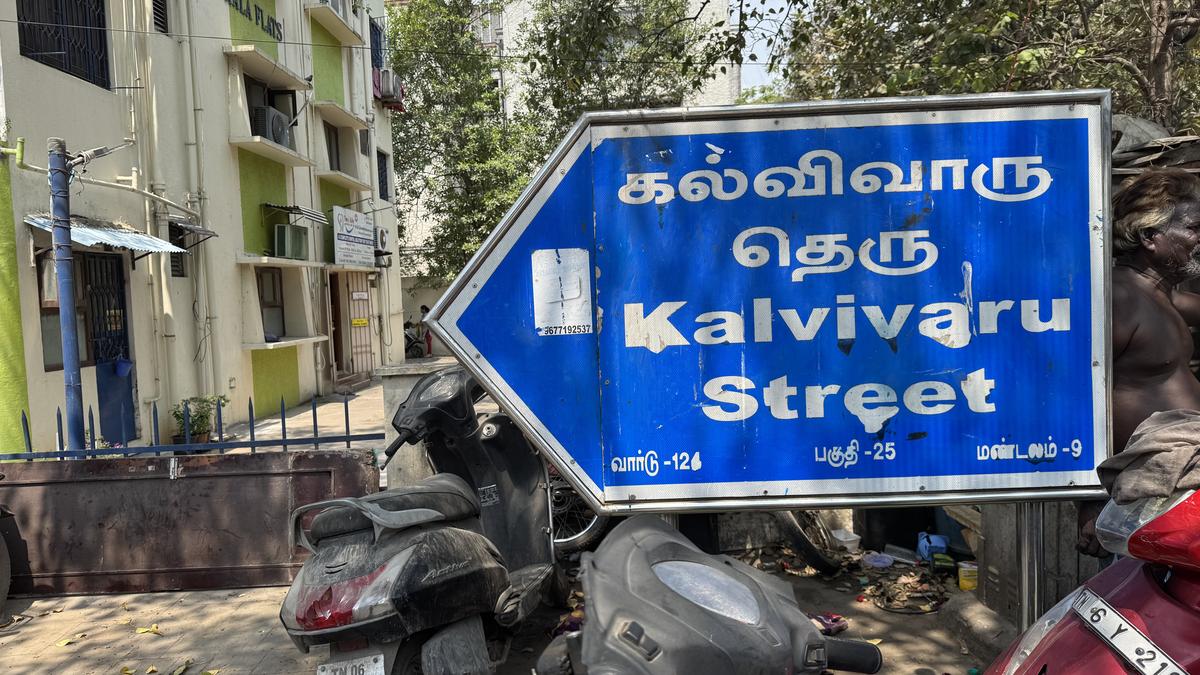Mystery resolved: Kalvi Varu Street connects the two wharves as can be seen in any city map. As late as 1962, the government sanctioned funds for strengthening of the wharves here.
At last, after years, I can sleep well at nights. Who, or what, was Kalvi Varu had been one of those unresolved mysteries thus far. And now, I think I have the answer.
Kalvi Varu Street is a narrow and short stretch running parallel to the Buckingham Canal. The MRTS looms overhead throughout the street and a high wall cuts off sight of and access to, but not the smells from, the Buckingham Canal.
Wide footpath
But, of the street itself, there are two parts. One is remarkably clean and with a wide footpath, seats under trees, and a play area, it is now serving as a highway — providing access to all types of vehicles when much of Royapettah High Road is dug up for the Metro Rail project. The rest of Kalvi Varu is essentially the rear of the Mundagakanni Amman Koil MRTS station.
The first part of the street was subject to a beautification and amenities project a few years ago which is when the reason behind the name came up for debate. And as is usual, wild theories abounded. Some said it had to do with the famed Calve Chetty family of Pondicherry as they had once owned property here. This was not true. Another group had it that since Vidya Mandir school abuts much of this road, it was named ‘Kalvi’ (education), though they conveniently forgot that there is a Varu attached as well. And considering that the school came up only in the 1950s, while the road was in existence even in the 1940s, this could not have been a correct explanation.
Preferred location
Several prominent people of Madras lived on this road from the 1940s onwards. Sir S. Varadachariar, judge of the Federal Court, was a resident, as was writer Guhapriyai. Who’s Who records of such people give the address only as Mylapore. In their time, this must have been a preferred residential location, with a frontage sloping down to the canal where boats laden with goods were punted. That the canal had a series of wharves where the boats halted is clear from sources.
One of them was the Mylapore wharf, which was close to the famed Hamilton/Ambattan/Barbers Bridge, now named after B.R. Ambedkar. The other was at Kutchery Road. The first provided a place to offload firewood and timber for which a huge godown stood where the Citi Centre Mall now is. The second was the access to the Taneer Turai (waterside) Market. This was a green initiative long before such ideas became fashionable. It was the brainchild of Sir V. Bhashyam Iyengar, a legal luminary who also served for a while as a judge of the High Court of Madras. The privately owned market was converted into a trust by Bhashyam Iyengar’s egalitarian son Desikan who made the vegetable vendors co-trustees.
Canal Wharf Street
Kalvi Varu Street connects the two wharves as can be seen in any city map. It was clearly Canal Wharf Street which became Kalvai Wharf/Varpu Theru and in turn Kalvi Varu Street. It is interesting to note that as late as 1962, the government sanctioned funds for strengthening of the wharves here, an activity that continued till 1970 when it was declared mysteriously complete. Plans also included a resthouse for boatmen. By then, the canal itself was non-functional but hopes remained of its revival until the MRTS put paid to such ideas. Taneer Turai Market ceased to have any logic and recently made way for residential high rise.
Nothing remains today of wharves, resthouses for boatmen, or for that matter any trace of water transport. And all this in just fifty years!
(V. Sriram is a writer and historian.)
Published – April 15, 2025 10:30 pm IST
